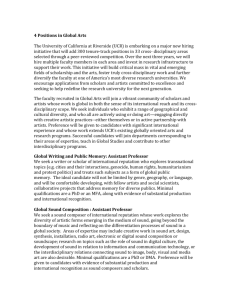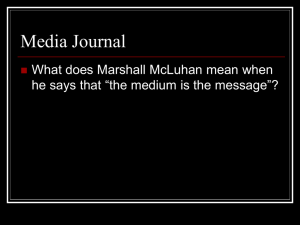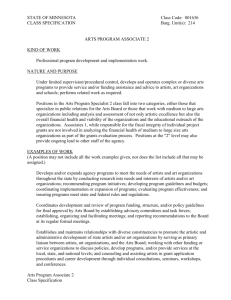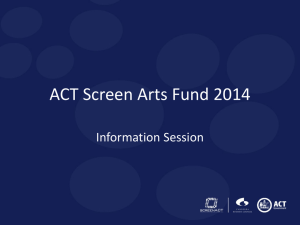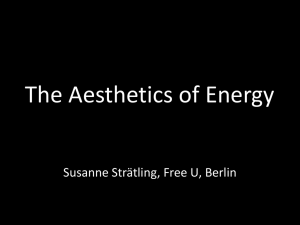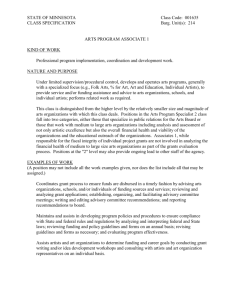Towards an office of institutional aesthetics
advertisement
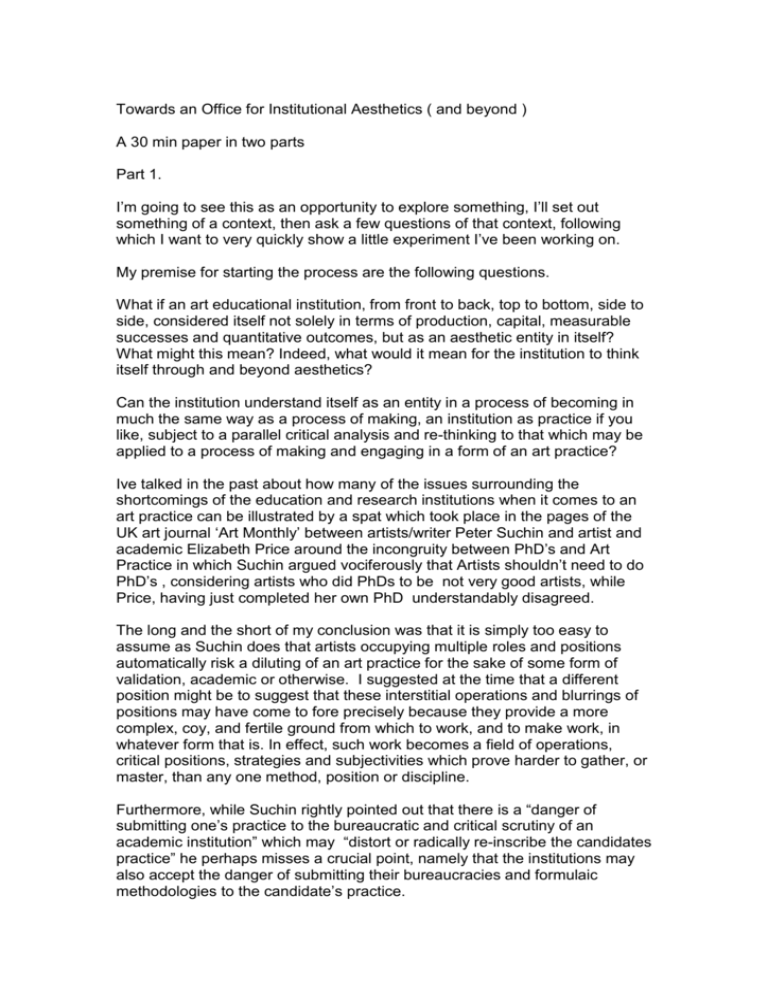
Towards an Office for Institutional Aesthetics ( and beyond ) A 30 min paper in two parts Part 1. I’m going to see this as an opportunity to explore something, I’ll set out something of a context, then ask a few questions of that context, following which I want to very quickly show a little experiment I’ve been working on. My premise for starting the process are the following questions. What if an art educational institution, from front to back, top to bottom, side to side, considered itself not solely in terms of production, capital, measurable successes and quantitative outcomes, but as an aesthetic entity in itself? What might this mean? Indeed, what would it mean for the institution to think itself through and beyond aesthetics? Can the institution understand itself as an entity in a process of becoming in much the same way as a process of making, an institution as practice if you like, subject to a parallel critical analysis and re-thinking to that which may be applied to a process of making and engaging in a form of an art practice? Ive talked in the past about how many of the issues surrounding the shortcomings of the education and research institutions when it comes to an art practice can be illustrated by a spat which took place in the pages of the UK art journal ‘Art Monthly’ between artists/writer Peter Suchin and artist and academic Elizabeth Price around the incongruity between PhD’s and Art Practice in which Suchin argued vociferously that Artists shouldn’t need to do PhD’s , considering artists who did PhDs to be not very good artists, while Price, having just completed her own PhD understandably disagreed. The long and the short of my conclusion was that it is simply too easy to assume as Suchin does that artists occupying multiple roles and positions automatically risk a diluting of an art practice for the sake of some form of validation, academic or otherwise. I suggested at the time that a different position might be to suggest that these interstitial operations and blurrings of positions may have come to fore precisely because they provide a more complex, coy, and fertile ground from which to work, and to make work, in whatever form that is. In effect, such work becomes a field of operations, critical positions, strategies and subjectivities which prove harder to gather, or master, than any one method, position or discipline. Furthermore, while Suchin rightly pointed out that there is a “danger of submitting one’s practice to the bureaucratic and critical scrutiny of an academic institution” which may “distort or radically re-inscribe the candidates practice” he perhaps misses a crucial point, namely that the institutions may also accept the danger of submitting their bureaucracies and formulaic methodologies to the candidate’s practice. The dialogue in AM350 between Price and Peter Suchin concerning Suchin’s article “Rebel without a Course” (in AM 345) is a good indication of the ongoing and complex set of problems for fine art academia and artists in its binary and polarised nature. Clearly, While it might be acknowledged that some of the institutional walls between what would traditionally be understood as art on the one hand and research on the other have began to crumble in the last decade, what is sometimes revealed in their absence is the lack of institutional capability to work with the new complexities and dynamics which may be ushered in as a consequence. Many artists work in some way or another at the interstices of art, art research, teaching, creative practice, writing and/or curation in some form or other. Occupying such a fertile environment it seems surprising that there would still appear to be an overly simplistic ontological split between ‘research’ and ‘art’. Surely it’s just all a lot more messy than that and perhaps we need to find ways to ensure our institutions should reflect that complexity. In this light I would suggest that an artist’s intention to approach a Phd is often less a means of achieving some spurious form of academic validation than of contributing to the increasingly amorphous, awkward and fluid practices which constitute the practice of art as a body of knowledge in the first place. If I was feeling wildly optimistic I might even go as far as to suggest that such a process may have significant implications for how we understand and work with, without, and/or against the institutions and cultures which produce us. What I want to go onto explore in a roundabout kind of way is the possibility that in an engaged art school it would be a two way street. To some extent what might be at stake in a PhD via art practice could be seen more as a collaborative re-thinking through practice of what might constitute knowledge in the first place, rather than a weak ( or ‘optimistic’ ) desire on the part of the candidate for institutional validation. To take this a step further, is it possible then for example to apply a form of model of artistic complexity as the shape around which the institution is organised? The implications of an active institutional engagement with this artistic research as an on going, yet productive, predicament rather than as a progressive drive towards the articulation of finite solutions, might positively affect a re-thinking of what artists and art educators mean by the conceptual frameworks of art practice, research and knowledge in the first place. It is up the artist/educators to go further into the muddy territory between being within the zone of art practice and the zone of art educational institutions along with their attendant bureaucratic structures and ask if there is a the possibility for the application of different types of ( poetic ) aesthetic, curatorial sensibilities which emerge out of reflexive practice onto and into the heart of the controlling rhetoric and processes which increasingly function as normative behaviour within many contemporary institutions of art and art education. Thinking of the Art School in particular as a site of an improbable , even impossible constellation of subjectivities and political and institutional imperatives is it possible to outline a speculative path through which the art and institution may begin to conflate in a zone of ‘possibilities’ which I have termed here as “Institutional Aesthetics”. If our institutions are end obsessed yet paradoxically one thing artistic research can tell us clearly is how to keep and eye on process. Those of us who straddle art and art-educational spheres may need to allow more residence and affect in our academies and understand how our practices and processes as artists might inform the institutions at their core rather than hiding, as if often the case, in their liminal spaces, and that this may be possible by re-thinking our institutions as a network of behaviours and tactics as opposed to external managerial and organizational structures, in much the same way we might encounter and engage in the process of art over the fetish of the artefact. If we are to try to imagine an aestheticised institution then we may need to be able to live and breath in complex and contradictory environments. Other options to the yes and the no1. This is a sign on my office door. A simple piece of paper no less but its flimsiness and paperiness announces itself in clear rhetorical terms. I am thin, handmade and vulnerable. On the sign are the hand drawn words “ The Office of Institutional Aesthetics”. It is an office, and yet not ‘an office’, it is merely a sign of an office. Indeed, its flimsiness and paperiness announces itself in fact a sign of ‘NOT’ office, not a real official office anyway. So the first task of the Office of Institutional Aesthetics is to announce itself as a work of something it is and isn’t, something which sits in a ‘flickering perceptual state’ ( to quote Julian Stallabrass talking about the practice of Liam Gillick). By accepting and announcing itself as an aestheticised entity it accepts and announces its impossibility to function still as an Office, yet here it is. It must exist, here is the sign on the door which says so. The Office sits on the top floor of an art and architecture building, at the top of the stairs along a corridor of moribund offices belonging to stressed senior academics and tutors. Or should that be stressed offices and moribund academics? The ‘flickering perceptual state’ of the office, between its paperiness and its officeness is an essential characteristic and this simple piece of paper as it sits at the top of a flight of stairs past which many staff and students have to pass to get the institutional office proper ( with its proper sign ). 1 Jan Verwoert The essential characteristics of the Office are aligned to characteristics of an art practice, in this case my art practice admittedly. Which begs the question is the office is an art practice? The answer would be yes, because I choose to call is such, and no because, its just an office. I am here reminded of the architectonic philosophical play of Arakawa and Gins, which affirms life by constructing spaces which are impossible to traverse, thus paradoxically embedding the refusal to die in them as a means to live, to keep trying to traverse. One of the characteristics of The Office includes an awareness and prioritisation of a becoming ( flowering ) over the fetish of progression ( flowered ). If the contemporary Higher Education institution has its eye on progressive tiering of knowledge and linear idea of progress ( as explemplified in the ideal of research as an ever growing movement towards ‘full knowledge’ ) then the Office recognises the counter model of Paul Virilio’s expanding sphere of knowledge in which, as more is known, the surface area of the known and the unknown becomes larger rather than smaller. The more we know the more we know that we know less than we thought we knew. This is why the lights not always on in the Office of Institutional Aesthetics Such inflections emanating and rippling in and out of an Office of Institutional Aesthetics (which holds a fragile papery sensibility of an art practice as its central methodology), might include processes of collage, gentle reversals, disruptions, folding, specificity, experimentations, flickering ontologies, contemplative analysis, pleasure, emotional affect, dialogue, cluelessness, horizontality, anti progress, the making of meaning or any such method which takes place in the sphere of art making. In order to look a little closer at some of these methods I’d like to very quickly show a piece of work very much in progress… Here are a few of those inflections. 1.SPECIFICITY Every pencil mark on the grain of the canvas is specific to a time, to a material, to subjective agencies, to culture, to history and ontologies. As every work of art is specific then every object of knowledge emerging from a process of artistic research demands its own methods, time and time again. Is it possible that our institutions acknowledge their own specifics in these terms . Thinking about the educational institutions I know best, its hard to imagine them as anything other than administrative machines 2. BOUNDARIES, NOT THINGS Dividing lines can be seen as the edges of canvases of course, the edges of frames but also as philosophical, political, linguistic, gendered, boundaries. Where the dividing lines collapse they collapse within other frames, in which case we have void, or vortex which sucks things in. The point at which the dividing lines collapse is an ‘event’ collapsing into, or onto the infinite number of other events, fragments, performances of the world. The Office’s new methodology encompasses the collapses as punctuation marks in in the process, failures perhaps, but failures which succeed in accessing the whole. Where the boundaries do not collapse completely we have DIFFERENCE which creates energy, and expansion. As in a practice we have a sense of what is near and what is far. The Office then is more like a score, which is performed slightly differently each time it is played. As in the studio it is important to be VERY calm, to work VERY SLOWLY, even if only for a few hours a day. And to stay within each boundary until it begins to collapse, then walk away. Adorno “ properly worked texts are like spiderwebs: hermetic, concentric, transparent, well-joined and fastened. They draw everything into themselves, whatever crawls and flies ( See Rheineburger here). Metaphors, which fleetingly dart through them, become their nourishing prey. Materials come flying to them. The binding stringency ( stichhaltigkeit ) of a conception is to be judged by whether its citations evoke other citations. Wherever the thought opens up a cell of reality, it must push into the next chamber, without an act of violence by the subject. It vouchsafes its relationship to the object, as soon as other objects crystallize around it. In the light that it sheds on its determinate object, others begin to gleam”2 3. THE USE OF LANGUAGE The artschool should be an ever changing testament to the mutability of language “the challenge is to encourage researchers in the arts to engage with these questions without simple recourse to an epistemic lexicon derived from philosophy, sociology or cultural studies.”3 4. ENGAGE IN DIALOGUE No 51. Adorno. Minima Moralia Interventions, Position Papers and Dialgues.Conclusion of Section 5. Share. Handbook for Artistic Research. Ed Mick Wilson and Schelte van Ruiten. P168 2 3 In a recent email exchange between myself and Henk Borgdorff I wrote the following which then became written up in the conclusion of the handbook of artistic research. SHARE 237 “Dialogue is key, as is the steady growth of the artistic research , in which the work can react to its own discoveries and realities. The criteria for assessment lie within the enfolding dialogue, between supervisor and candidate, between material practice and formal assessment. Criteria , could and perhaps should, always be ‘in becoming’, emerging , as in the work of art, out of a tension between the internal logic of the work itself and external standards or judgements.” 4 I think by this I mean, if we take the painting again, to be able to engage in a change of register in dialogue. 5. THINK HORIZONTALITY Let us consider in this instance work of art as horizontal and flat. “Horizontality is not an instrument for making everyone present the same, but rather an instrument for creating a social space in which everyone feels empowered to speak and to take part of common challenges as a different and similar singularity”5 “ horizontality is a processual practice that takes time and patience”6 If, as according to Pascal Gelien, Institutuons are ‘verticality ‘ machines, then think of the Office as a horizontality machine, whereby the shape is more like a net, or a cobweb which Rheinbeuger describes in his ‘experiemental ‘ systems as a means of ‘catching something unexpected’ As Gelien goes onto say, “critique of the institution is only possible thanks to the shelter of that same instituion and the values it represents” ( p 15 ), what Jan Verwoert decribed as being like ‘the nun talking to the devil.’ This pact, in which both sides invest heavily and rely on each other to consider themselves as ‘realities’ is seemingly impossible to dismantle, or is it? Some strategies , tactics and perfomativites which take place in a practice which do not CARE for verticalities, indeed, could be said to increase the potential for horizontality ( which does not rule out depth? ) and yet in the general construction of our art institutions we tend to ignore the sensibilieies of practice, in order that our instituins house practice rather than are 4 P237 Dutton Share Handbook Isabell Lorey, On democracy and occupation. Institutional Attitudes:Instituting Art in a Flat World. Ed Pascal Gielen. Antennae Series no 8 by Valiz, Amsterdam, part of the Fonty’s series Art in Society p.84 6 Ibid p85 5 inhabited or housed by it. This is problematic on several counts, forstly the schizoid behavours are exhausting, the constant conflict, often internalised in nervous exhastionm, secondly, artist/mamageres tend to increase levels of buraicary rather than decrease in order to ( stupidly ) attemot to safeguard their pratice from the damaging effects of the very intituin they occupy. In short, they lack nerve to tackle the verticality from within, preferring to keep the illusion that the instituins is from of machine which remains clean from its productions. 6. FIND THE TENDER SPOT SLIDE 10 In Institutional Attitudes: Instituting Art in a Flat World Blake Stimson sees institutions as a check if they focus on what he describes as the ‘tender spot’ and it this tender spot which is the focus of the Office of Institutional Aesthetics. The tender spot being a described in the afterword as “space that can open up between a regime of truth and a regime of truth proper, the space in which meaningfulness might still be found in any folder or object”7 For me, in respect of the practice, the tender spot is the point at which languages conflate into a zone of possibitlies. 7. TURN OFF THE LIGHT. ACCEPT CLUELESSNESS IN THE DARK. Why do the institutions somehow fear the deepest stirrings of the human heart? To explore loss, or fear. Have we simply reached a period when objectivity is all? Think of Peter Sloterdijk, a coalescing of insight, turn of phrase, inwards and outwards, a product of explorations in the dark…should this be shameful? Is it shameful to speak? Again, I think of the change in register. In a conversation between Hans Ulrich Obrist and Daniel Birnbaum, Birnbaum stated matter of factly that his job as a curator is to explore the human soul ( it is nothing less)? Thinking about being in the dark. In thinking about this inhabitation of the problem I’m drawn to remeber Silke Otto-Knappe’s gloomy, opalescent paintings of the woods and forests in which Emile Nolde stayed at the lowest point in his depression, in which the gloom is referred to ( is sanctioned by ) the ‘quotation’ of Nolde’s depression. Otto-Knappe inhabits his own soul ( and mine ) via Nolde’s exploration of his own darkness. Afterword. P233 .Institutional Attitudes:Instituting Art in a Flat World. Ed Pascal Gielen. Antennae Series no 8 by Valiz, Amsterdam, part of the Fonty’s series Art in Society p.84 7 8. CONTRADICTIONS and MISTAKES I can only think from where I am, therefore I want to change I have to be where I am not ( SD ) Adorno. “ A successful work is not one that resolves objective contradictions in a spurious harmony, but one that expresses the idea of harmony negatively by embodying the contradictions, pure and uncompromised, in its innermost structure.”8 Its important that the office of institutional aesthetics does not hide its weaknesses and mistakes, this is critical in a horizontal world. Transparent Mistakes are apparent potentials. Opaque mistakes are closures. Thinking about the words of Jacques Ranciere, ‘Aesthetics is the ability to think contradiction9’. Is there an argument for an institutions that refuses to isolate waywardness or incomprehensibility or cluelessness as a lazy or uncritical approach, and indeed, on the contrary to suggest that such an approach is engaged, possibly politicised and recognises such attitudes as contradiction or confusion as aesthetic empowering, libidinal and political forces. If so, is it possible to argue that this impossibility (or difficulty) of classification, (which applies first and foremost to what we think we are doing, hence, if we don’t now what we are doing we must be ‘clueless’) This refusal (or inability) to ‘focus’ when one is clueless is in itself a highly charged force which, at its centre promotes a deeply profound and necessary critical distance and attempt at detachment in order to play within what could be seen as the atomising effects of the twin neo-liberal obsessions of enterprise and innovation, to the extent that an art practice can present another model of confusion, in which tensions and stresses, contractions and disturbances, mistakes and malapropisms have aesthetic and dynamic dimensions and effects which may experienced as a form of deep critical ‘pleasure’ and effect? In the words of the Raqs Media Collective10 “The tree of life, and therefore of art, would be barren were it not for the fruit of occasional misunderstandings”. 9. TO PROGRESS OR DIGRESS? Ibid 137 the politics of the aesthetic, first seen in Claire bishop article the social turn? Art forum.. 10 in E-Flux Journal no 14.. 8 9 Man Ray- art doesn’t progress, there are just different ways of doing it 10. RELAX Franz West..”the best way to exercise the mind is to relax”. PRESS THE PAUSE BUTTON. The Office contains a number of beds and sofas. Sometimes, nothing really happens in the Office of Institutional Aesthetics. Co-opted by capital the institutions are generally entirely caught up in the process of ‘production’ , the production of students, employable and polyvalent. To do so institutions work on yearly cycles, rhythmic production line models, repetition in structure, and delivery and ever increasing targets. Its difficult to DWELL in such fast moving yet repetitive world. Robin Helmey defines being human not as knowledge of mortality or as the ability to laugh ( which in my view may be closely linked anyway SD) but as the capacity to break out of your routine.11 The power of the contemporary art education institution is in its speed but this power and super fast turn over makes a mockery of effectiveness. FINALLY On making The institution frequently Does without making On making On making “ Doing, without the enriching component of making, is largely utilitarian, often repetitious and frequently banal; making, on the contrary, is engrossing, dynamic and often its own reward, whatever usefulness its products may possess. In making we move from nothing to something; from the speculative to the determined; from the unknown ( or only partially known ) to the known”.12 END David Sheilds How Literature Saved My Life. P65 . Notting Hill Editions Ltd. 2003 12 Jeremy Cox. Preface to The Artistic Turn: A manifesto ed . by Kathleen Coessens, Darla Crispin , Anne Douglas. P 7-8. 11
